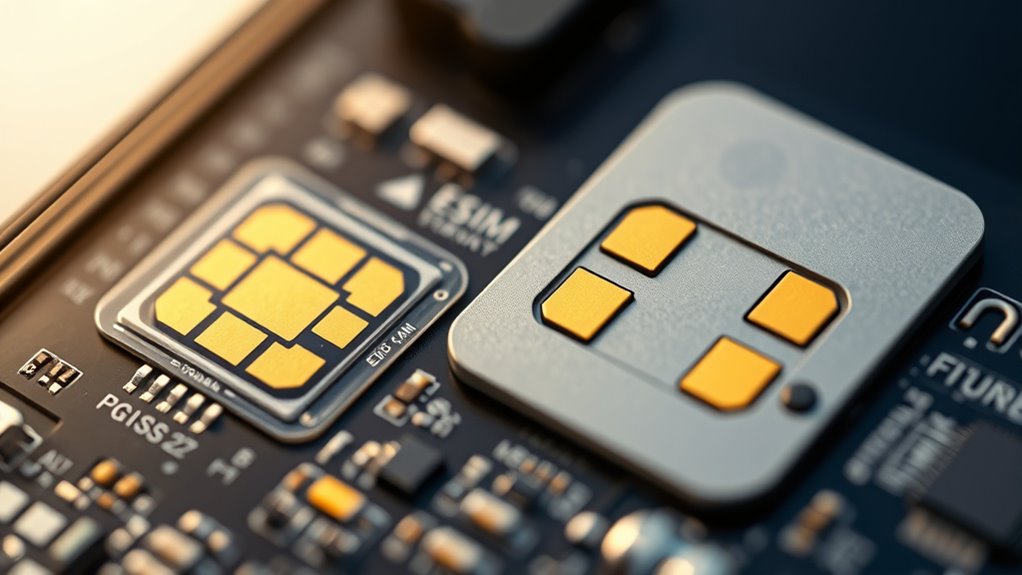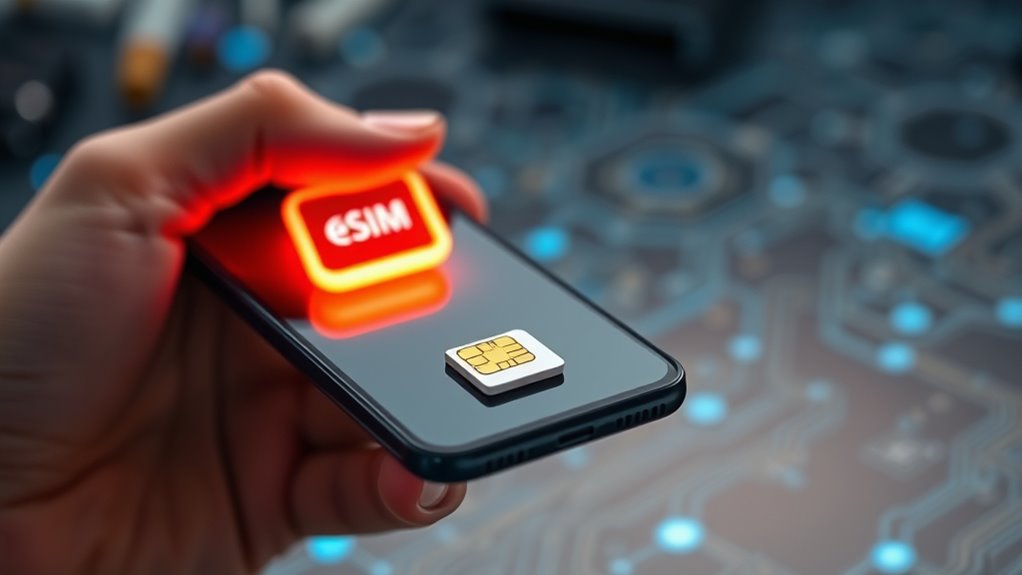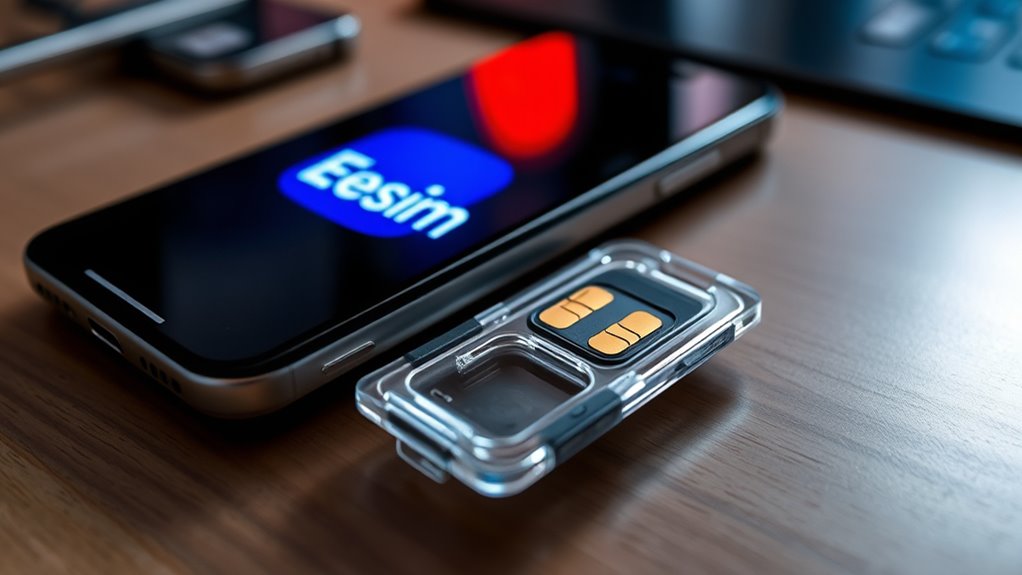If you compare eSIMs and physical SIMs, you’ll find eSIMs offer easier remote carrier switches, device design benefits, and better security, but face compatibility and transfer challenges. Physical SIMs are widely compatible, simple to swap, and cost-effective—ideal for emergencies and low-tech needs. Future trends show eSIMs dominating in smartphones, IoT, and wearables, making connectivity more seamless. Exploring these options further will help you choose the best solution for your tech needs.
Key Takeaways
- eSIMs enable remote carrier switching and device customization, offering greater convenience but may face compatibility issues in certain regions.
- Physical SIMs are universally compatible and easy to transfer, making them reliable for various devices and locations.
- Future trends indicate eSIM adoption will surpass 60% of smartphones by 2025, driven by IoT growth and miniaturization.
- eSIMs enhance device design, security, and remote management, while physical SIMs provide simplicity and tangible control.
- The choice between eSIM and physical SIM depends on device compatibility, regional network support, and user needs for flexibility or simplicity.
Understanding the Basics of Esim and Physical SIM

To understand the basics of eSIM and physical SIM cards, it’s important to know what each one is and how they function. Physical SIMs are removable cards that connect your device to cellular networks. They store essential subscriber information like IMSI and ICCID, which allow network access. You can change carriers by swapping out the SIM card, but this requires physically replacing it. Most older devices and some newer ones still use these traditional SIMs. On the other hand, an eSIM is built into your device, eliminating the need for a physical card. It stores subscriber data digitally, enabling you to switch carriers or plans remotely by scanning QR codes or entering activation codes. While physical SIMs are more universal, eSIMs offer greater flexibility and are embedded directly into newer devices. Additionally, eSIM technology supports seamless remote provisioning that enhances user convenience. The shift towards eSIMs also aligns with digital innovation trends in the telecommunications industry. As technology advances, eSIMs are becoming more widely adopted, which is driven by the increasing special events and themed breakfasts in various sectors, highlighting the importance of adaptable connectivity solutions for diverse applications.
Advantages of Using Esim Technology

Using eSIM technology offers significant advantages that enhance your mobile experience. First, it provides unmatched flexibility and convenience—allowing you to switch carriers, activate plans remotely, and manage multiple profiles effortlessly. This means no more physical SIM swaps or waiting for delivery. Second, it benefits device design by freeing internal space, enabling slimmer, more durable phones with larger batteries and better performance. Additionally, eSIMs can support tuning capabilities, allowing for remote adjustments and optimizations of device settings. Moreover, the integration of sound healing science principles suggests that these advancements could potentially improve user well-being through optimized device performance, contributing to a healthier digital environment. Furthermore, improved color accuracy ensures that displays on devices utilizing eSIM technology render images more precisely, enhancing user experience. Enhanced security features of eSIMs also help to protect user data and prevent unauthorized access. Finally, it boosts security and reliability; your virtual profile is securely stored, reducing risks of damage or theft, and enabling quick disablement if your device is lost. Incorporating wearable technology with eSIMs can further extend these benefits to health monitoring and personal wellness.
Drawbacks of Relying on Esims

While eSIM technology offers notable benefits, it also comes with certain limitations that can affect your experience. One major issue is device compatibility; not all smartphones support eSIM, especially regional models in places like China or older high-end devices. This restricts access and makes switching less flexible. Additionally, switching devices isn’t straightforward—eSIM profiles are not easily transferable, often requiring reactivation and carrier support. Activation can also be complicated, depending on your location, carrier, and language barriers, making setup frustrating for some users. Security concerns exist too: eSIMs are harder to physically remove, which may raise privacy worries and increase tracking risks. Finally, regional coverage and network availability can limit eSIM use in rural areas or certain countries, reducing its global utility. Furthermore, cybersecurity vulnerabilities related to eSIM profiles could be exploited if proper protections are not in place. The device ecosystem for eSIMs is still evolving, which may lead to inconsistencies in user experience across devices and carriers. Additionally, the integration with network infrastructure is still developing, potentially impacting performance and reliability in some regions. Limited regional support can also hinder consistent service in international travel or remote locations.
Benefits of Traditional Physical SIM Cards

Traditional physical SIM cards offer broad compatibility across virtually all mobile devices and networks, making them a reliable choice for most users. You can easily transfer a SIM card between devices, ensuring immediate access to your preferred network without reconfiguration. This simplicity means no internet or digital activation is needed when switching phones, making changes quick and hassle-free. Plus, physical SIMs give you tangible control over your mobile identity, allowing you to remove or swap cards to protect your privacy or manage multiple accounts. They’re also familiar, with a straightforward setup that reduces errors and simplifies repairs. And because they’re widely available and inexpensive, they’re perfect for low-tech environments, prepaid plans, or emergencies. These benefits make physical SIM cards a dependable, user-friendly option.
Emerging Trends and Future Outlook for SIM Technologies

The landscape of SIM technology is rapidly evolving, with eSIMs leading the charge toward a more connected and flexible future. By 2025, eSIM adoption will surge across smartphones, laptops, smartwatches, and IoT devices, with over 60% of smartphone sales compatible. Expect 2 to 3 billion smartphone connections using eSIMs and a 43% rise in IoT connections, making devices smarter and more integrated. Advancements like biometric security, AI fraud detection, 5G integration, and real-time plan customization will enhance user experience and security. These innovations will support global connectivity and enable devices to switch networks effortlessly and eliminate the need for physical SIM swaps. As eSIM technology miniaturizes, it will emancipate new possibilities in wearables and IoT, shaping a seamless, personalized digital future. Additionally, creating a cohesive ecosystem that integrates hardware and software will be crucial for maximizing the potential of these emerging SIM technologies. Recognizing how prophetic dreams have historically influenced human understanding can inspire innovative approaches to integrating new technologies into our daily lives. Moreover, understanding the physical characteristics of emerging SIM modules can help in designing more efficient and durable devices that accommodate these advanced features.
Frequently Asked Questions
Can I Use Both Esim and Physical SIM SIMultaneously on One Device?
You can use both an eSIM and a physical SIM simultaneously on your device. Most modern smartphones support this feature, allowing you to manage two lines at once. You can make calls, send texts, and use data on both, but only one active data connection at a time. This setup is perfect for separating work and personal numbers or traveling internationally without swapping SIM cards. Just check your device’s compatibility and settings.
How Do Esims Impact Device Repair or Replacement Processes?
When it comes to device repair or replacement, eSIMs simplify the process because there’s no physical card to handle, reducing risks like loss or damage. You’ll need to re-activate your profile on a new device, often via a QR code or activation code from your carrier. Future updates will likely make reactivation faster with remote provisioning, streamlining repairs and replacements even more, and minimizing downtime.
Are Esims Compatible With All International Carriers?
You might wonder if eSIMs work with all international carriers. While many major carriers worldwide support eSIM technology, compatibility varies by country and provider. In regions like Europe, North America, and parts of Asia, support is widespread, but some carriers and countries still have limited or no eSIM options. Always check with your carrier before traveling to verify your eSIM will work seamlessly, especially in less-supported areas.
What Are the Privacy Implications of Using Esims Versus Physical SIMS?
You might think eSIMs are more private than physical SIMs, but they share similar privacy risks. Both track your activity and can be targeted by hackers through SIM swapping or malware. However, eSIMs are harder to steal or clone since they’re embedded, and they offer remote management, adding security layers. Still, your location data and device info can be shared with multiple entities, so privacy depends on your app permissions and carrier policies.
How Will Esim Adoption Influence the Future of Mobile Device Design?
You’ll see eSIM adoption shaping the future of mobile device design by enabling sleeker, more innovative forms. Without physical slots, manufacturers can optimize internal layouts for bigger batteries, better cooling, and advanced cameras. This shift also improves water resistance and environmental impact. As eSIMs become standard, expect more compact, versatile devices, like foldables and wearables, offering seamless connectivity and user convenience, transforming how you interact with technology daily.
Conclusion
As you weigh the choice between eSIMs and physical SIMs, remember that technology is always evolving—like a river forever flowing forward. While eSIMs offer sleek convenience and potential for innovation, traditional SIM cards still hold their ground with familiarity and reliability. The future may hold surprises, but your decision now shapes your connectivity journey. Embrace the change, and stay prepared for what’s next, because in tech, adaptability is the key to staying ahead.









